
- Antique Imperial Russian
- Brand
- Antique (105)
- Carl Faberge (8)
- Faberge (134)
- Fabergé (33)
- Gustav Klingert (8)
- Handmade (12)
- Imperial (105)
- Imperial Russian (35)
- Ivan Khlebnikov (12)
- Khlebnikov (10)
- Monogram Tea Holder (7)
- Ovchinnikov (6)
- Paul Buhré (6)
- Pavel Ovchinnikov (6)
- Rare (13)
- Russian (47)
- Russian Imperial (10)
- Signed (7)
- Silver 84 (9)
- Unknown (10)
- Other (2296)
- Department
- Metal
- Metal Purity
- Type
- Vintage
Imperial Russian Samovar By Batashev Award Stamped 1870 to 1882 Brass Antique
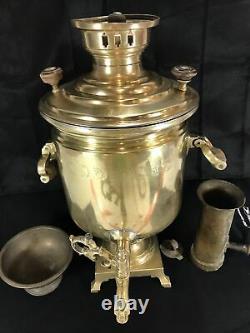
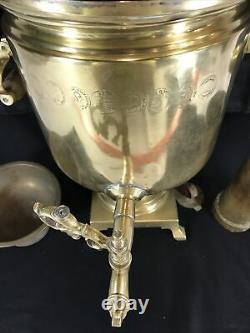
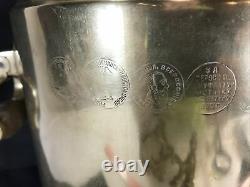

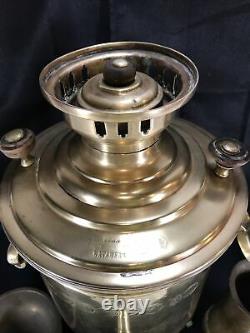

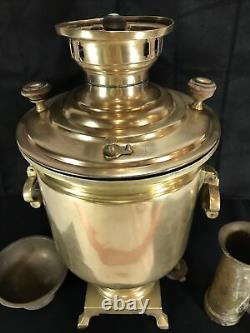
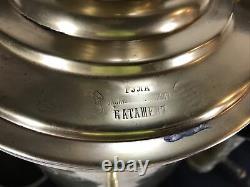
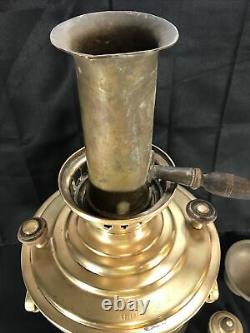


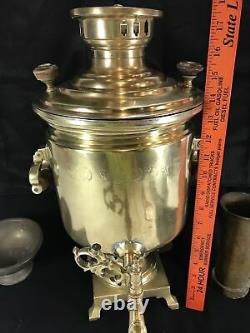


8 Awards stamped 1870 to 1882 Antique Brass Authentic. Brass Russian Samovar, or tea urn, from the late Imperial Russia. 18 inches in height, (23 with chimney), and approximately 9 inches in diameter. It is heavy and weighs almost 11 pounds. It has wood-covered stirrup handles. It comes with a drip bowl, chimney, and damper top.
The latch for the clean-out on the bottom is detached but is included. The samovar was recently polished except for the drip bowl and chimney. There are no large noticeable dings or dents. There is some minor dings and scratches and the top cap is a little.
The samovar was filled with water and held, the spout works fine. Pine cones or small pieces of wood were traditionally used in the middle to heat the water. Overall the samovar has been used but is very clean.
Please view all pictures for more information and condition. More information about the information on this samovar. LID: Center, in old Russian: Tula. BASE: Vasiliy Stepanovich BatashevTo its left and to its right there are 4 seals that cannot be read, one of them says 1870.
On the BODY of the samovar are 8 award stamps. DEM Verownrve and an image. According to Wikipedia, Weltausstellung 1873 Wien is the German for. 1873 Vienna World's Fair. That was held in 1873 in the. As well as being a chance to showcase Austro-Hungarian industry and culture, the World's Fair in Vienna commemorated. Second seal on the right: Franz Jose... And a facial profile image. To its right: profile image and inscription in old Russian, All-Russia emperor Alexander.To its right: inscription in old Russian: For All-Russian Manufacturing Exhibition in Saint Petersburg 1870. To its right: a profile image and an inscription in Cyrillic alphabet, but not in Russian maybe in Bulgarian? To its right: an image of something and an inscription in Russian, All-Russian Exhibition 1882. To its right: a profile of a bearded man and an inscription in Latin alphabet letters: Desbeloes 1876 could be in Greek?
Last seal: olive branches all around and an inscription in Latin Alphabet letters maybe in Italian? Is a metal container traditionally used to heat and boil water. The samovar is well known outside of Russia and has spread through Russian culture to. And is also known in some parts of. Since the heated water is typically used to make.
Many samovars have a ring-shaped attachment. Around the chimney to hold and heat a.
Many newer samovars use electricity to heat water in a manner similar to an. Antique samovars are often prized for their beautiful workmanship.
At the end of the nineteenth century there were several centers of samovar production, but soon Tula was the only city where all varieties of these devices were mass produced. Here were born the famous names of the Batashevs, the Vorontsovs, the Shemarins, Lomova, Teyle. Tula samovars were exported and won Russian and international awards. In 1870, at the All-Russian manufactory exhibition, they received a silver medal for samovars and the organization of production.
In 1883, a gold medal was received at the Amsterdam exhibition. In 1885, the factory of Batashev brothers represented the largest samovars production in Tula. In 1890, the brothers decided to divide joint property. The right for a brand "Brothers Vasily and Alexander Batashevy" remained for Vasily and the right to change a brand at discretion. In 1897, after Vasily's death, the husband of his oldest daughter took over production management.
The factory Vasily Batashev began to be called Partnership of steam samovar factory heirs. Vasily Stepanovich Batashev in Tula. The first historically recorded samovar-makers. Brothers, Ivan Fyodorovich Lisitsyn and Nazar Fyodorovich Lisitsyn.
Since their childhood, they were engaged in metalworking at the brass factory of their father, Fyodor Ivanovich Lisitsyn. In 1778, they made a samovar, and the same year Nazar Lisitsyn registered the first samovar-making factory in Russia. They may not have been the inventors of the samovar, but they were the first documented samovar-makers, and their various and beautiful samovar designs became very influential throughout the later history of samovar-making. These and other early producers lived in.A city known for its metalworkers and arms-makers. Since the 18th century, Tula has also been the main center of Russian samovar production, with T.
Being the brand mark of the city. A Russian saying equivalent to. " is "to travel to Tula with one's own samovar. Region were among the first Samovar producers, over time several samovar producers emerged all over Russia, which gave the samovar its different local characteristics.
By the 19th century, samovars were already a common feature of Russian tea culture. They were produced in large numbers and exported to. The samovar was an important attribute of Russian households and. It was used by all classes, from the poorest peasants, up to the most well-suited people. The Russian expression "to have a sit by the samovar" means to have a leisurely talk while drinking tea from a samovar. In everyday use, samovars were an economical permanent source of hot water, in older times. The item "Imperial Russian Samovar By Batashev Award Stamped 1870 to 1882 Brass Antique" is in sale since Tuesday, June 29, 2021. This item is in the category "Collectibles\Cultures & Ethnicities\Russian".The seller is "butmymamasaid" and is located in Granby, Connecticut. This item can be shipped to United States, Canada, United Kingdom, Denmark, Romania, Slovakia, Bulgaria, Czech republic, Finland, Hungary, Latvia, Lithuania, Malta, Estonia, Australia, Greece, Portugal, Cyprus, Slovenia, Japan, China, Sweden, South Korea, Indonesia, Taiwan, South africa, Thailand, Belgium, France, Hong Kong, Ireland, Netherlands, Poland, Spain, Italy, Germany, Austria, Bahamas, Israel, Mexico, New Zealand, Philippines, Singapore, Switzerland, Norway, Saudi arabia, Ukraine, United arab emirates, Qatar, Kuwait, Bahrain, Croatia, Malaysia, Chile, Colombia, Costa rica, Panama, Trinidad and tobago, Guatemala, Honduras, Jamaica, Antigua and barbuda, Aruba, Belize, Dominica, Grenada, Saint kitts and nevis, Saint lucia, Montserrat, Turks and caicos islands, Barbados, Bangladesh, Bermuda, Brunei darussalam, Bolivia, Egypt, French guiana, Guernsey, Gibraltar, Guadeloupe, Iceland, Jersey, Jordan, Cambodia, Cayman islands, Liechtenstein, Sri lanka, Luxembourg, Monaco, Macao, Martinique, Maldives, Nicaragua, Oman, Pakistan, Paraguay, Reunion, Uruguay.
- Provenance: Ownership History Not Available
- Featured Refinements: Russian Samovar
- Country/Region of Manufacture: Russian Federation
- Modified Item: No
- Culture: Russian

